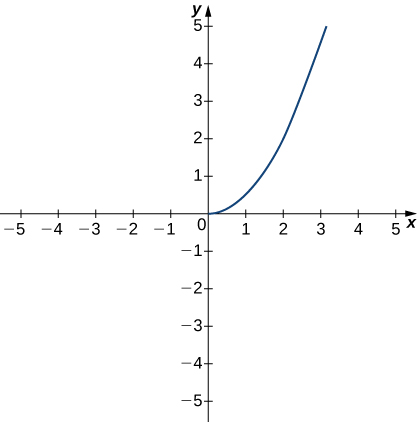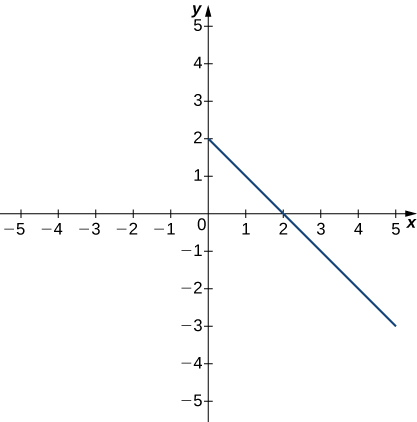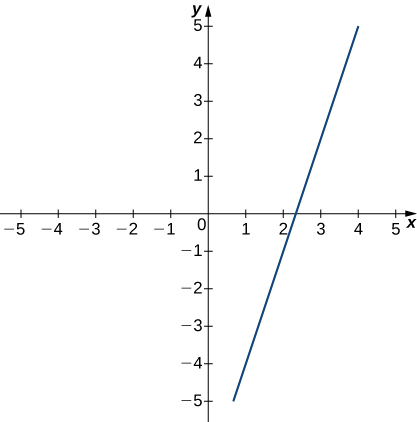2.5E: Exercises for Section 2.5
- Last updated
- May 26, 2022
- Save as PDF
- Page ID
- 102701

- Zoya Kravets
- Mission College
( \newcommand{\kernel}{\mathrm{null}\,}\)
In exercises 1 - 4, write the appropriate ε−δ definition for each of the given statements.
1) limx→af(x)=N
2) limt→bg(t)=M
- Answer
- For every ε>0, there exists a δ>0, so that if 0<|t−b|<δ, then |g(t)−M|<ε
3) limx→ch(x)=L
4) limx→aφ(x)=A
- Answer
- For every ε>0, there exists a δ>0, so that if 0<|x−a|<δ, then |φ(x)−A|<ε
The following graph of the function f satisfies limx→2f(x)=2. In the following exercises, determine a value of δ>0 that satisfies each statement.

5) If 0<|x−2|<δ, then |f(x)−2|<1.
6) If 0<|x−2|<δ, then |f(x)−2|<0.5.
- Answer
- δ≤0.25
The following graph of the function f satisfies limx→3f(x)=−1. In the following exercises, determine a value of δ>0 that satisfies each statement.

7) If 0<|x−3|<δ, then |f(x)+1|<1.
8) If 0<|x−3|<δ, then |f(x)+1|<2.
- Answer
- δ≤2
The following graph of the function f satisfies limx→3f(x)=2. In the following exercises, for each value of ε, find a value of δ>0 such that the precise definition of limit holds true.

9) ε=1.5
10) ε=3
- Answer
- δ≤1
[T] In exercises 11 - 12, use a graphing calculator to find a number δ such that the statements hold true.
11) |sin(2x)−12|<0.1, whenever |x−π12|<δ
12) |√x−4−2|<0.1, whenever |x−8|<δ
- Answer
- δ<0.3900
In exercises 13 - 17, use the precise definition of limit to prove the given limits.
13) limx→2(5x+8)=18
14) limx→3x2−9x−3=6
- Answer
- Let δ=ε. If 0<|x−3|<ε, then |x2−9x−3−6|=|(x+3)(x−3)x−3−6|=|x+3−6|=|x−3|<ε.
15) limx→22x2−3x−2x−2=5
16) limx→0x4=0
- Answer
- Let δ=4√ε. If 0<|x|<4√ε, then |x4−0|=x4<ε.
17) limx→2(x2+2x)=8
In exercises 18 - 20, use the precise definition of limit to prove the given one-sided limits.
18) limx→5−√5−x=0
- Answer
- Let δ=ε2. If −ε2<x−5<0, we can multiply through by −1 to get 0<5−x<ε2.
Then |√5−x−0|=√5−x<√ε2=ε.
19) limx→0+f(x)=−2, where f(x)={8x−3,if x<04x−2,if x≥0.
20) limx→1−f(x)=3, where f(x)={5x−2,if x<17x−1,if x≥1.
- Answer
- Let δ=ε/5. If −ε/5<x−1<0, we can multiply through by −1 to get 0<1−x<ε/5.
Then |f(x)−3|=|5x−2−3|=|5x−5|=5(1−x), since x<1 here.
And 5(1−x)<5(ε/5)=ε.
In exercises 21 - 23, use the precise definition of limit to prove the given infinite limits.
21) limx→01x2=∞
22) limx→−13(x+1)2=∞
- Answer
- Let δ=√3N. If 0<|x+1|<√3N, then f(x)=3(x+1)2>N.
23) limx→2−1(x−2)2=−∞
24) An engineer is using a machine to cut a flat square of Aerogel of area 144cm2. If there is a maximum error tolerance in the area of 8cm2, how accurately must the engineer cut on the side, assuming all sides have the same length? How do these numbers relate to δ, ε, a, and L?
- Answer
- 0.033 cm,ε=8,δ=0.33,a=12,L=144
25) Use the precise definition of limit to prove that the following limit does not exist: limx→1|x−1|x−1.
26) Using precise definitions of limits, prove that limx→0f(x) does not exist, given that f(x) is the ceiling function. (Hint: Try any δ<1.)
- Answer
- Answers may very.
27) Using precise definitions of limits, prove that limx→0f(x) does not exist: f(x)={1,if x is rational0,if x is irrational. (Hint: Think about how you can always choose a rational number \(0
28) Using precise definitions of limits, determine limx→0f(x) for f(x)={x,if x is rational0,if x is irrational. (Hint: Break into two cases, x rational and x irrational.)
- Answer
- 0
29) Using the function from the previous exercise, use the precise definition of limits to show that limx→af(x) does not exist for a≠0
For exercises 30 - 32, suppose that limx→af(x)=L and limx→ag(x)=M both exist. Use the precise definition of limits to prove the following limit laws:
30) limx→a(f(x)−g(x))=L−M
- Answer
- f(x)−g(x)=f(x)+(−1)g(x)
31) limx→a[cf(x)]=cL for any real constant c (Hint: Consider two cases: c=0 and c≠0.)
32) limx→a[f(x)g(x)]=LM. (Hint: |f(x)g(x)−LM|=|f(x)g(x)−f(x)M+f(x)M−LM|≤|f(x)||g(x)−M|+|M||f(x)−L|.)
- Answer
- Answers may vary.

